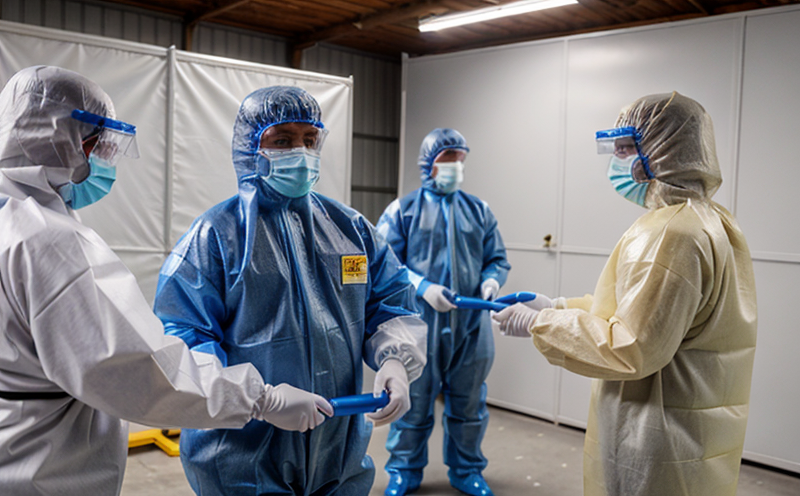GB T 24541 Heat and flame resistance of workwear fabrics
The PRC national standard GB/T 24541-2009 specifies the requirements, test methods, marking rules, and acceptance criteria for heat and flame resistance performance testing on workwear fabrics. This standard is crucial in ensuring that protective clothing provides adequate protection to workers exposed to fire hazards or high temperatures.
The scope of this standard includes various types of fabric materials used in manufacturing protective garments such as jackets, trousers, aprons, etc., which are intended for use by personnel working in environments where they might encounter flame or heat. The primary objective is to evaluate the resistance of these fabrics against thermal exposure and flaming conditions.
The testing methods outlined within GB/T 24541 involve both direct flame exposure as well as radiant heat exposure scenarios. These tests simulate real-world situations that workers may face while wearing protective clothing, providing a comprehensive assessment of fabric performance under different environmental stressors. Compliance with this standard ensures that the materials used in manufacturing protective garments meet safety standards set forth by relevant authorities.
Before conducting any test according to GB/T 24541, proper specimen preparation is essential. Specimens should be cut from the same batch of fabric and prepared under controlled conditions ensuring they are representative of actual products. This includes considerations such as width, length, thickness, and orientation relative to the directionality of weave patterns.
Once specimens have been prepared appropriately, they undergo rigorous testing procedures designed to measure key parameters related to heat resistance performance including: after-flame time; after-smoldering duration; maximum temperature rise during exposure; residual mass after exposure; etc. Results from these tests provide valuable insights into the effectiveness of different fabrics when used in protective clothing applications.
The results obtained through GB/T 24541 testing are reported using clear, concise language along with appropriate numerical values indicating compliance or non-compliance with specified limits set forth by this standard. Reporting typically includes details about the type of fabric tested; relevant test conditions including temperature and duration; observed outcomes during each phase of testing; calculated metrics derived from measurements made throughout the process; comparison against established acceptance criteria; and final determination regarding whether or not the material meets required specifications.
Compliance with GB/T 24541 demonstrates a commitment to worker safety by ensuring that protective clothing effectively protects individuals from potential hazards associated with fire or extreme heat. By adhering to this standard, manufacturers can ensure their products meet stringent quality controls and pass regulatory inspections.
Benefits
The implementation of GB/T 24541 ensures that workwear fabrics possess the necessary properties needed for effective protection against heat and flames. This leads to enhanced safety standards, reduced risk exposure for workers operating in hazardous environments, improved comfort levels due to optimized fabric design, increased durability resulting from appropriate material selection, cost savings through efficient production processes based on validated test results.
For quality managers responsible for overseeing product development and manufacturing processes, adherence to this standard provides peace of mind knowing that their products comply with recognized international standards. Compliance also facilitates smoother interactions between suppliers and buyers by establishing common ground regarding expectations around fabric performance characteristics.
From a compliance officer perspective, meeting these requirements helps avoid legal issues associated with non-compliance, thereby protecting both the organization’s reputation and potential financial losses due to recalls or product liability claims. R&D engineers benefit from having clear guidelines on what constitutes acceptable levels of heat resistance for different types of fabrics, allowing them to innovate within defined parameters while still delivering safe solutions.
Lastly, procurement professionals gain assurance knowing that when sourcing materials for protective clothing, they are selecting suppliers who meet rigorous quality benchmarks established by GB/T 24541. This fosters long-term partnerships built on trust and reliability among all parties involved in the supply chain process.
Industry Applications
| Industry Sector | Specific Applications |
|---|---|
| Bldg. Maintenance | Protective clothing for roofers, electricians working near live wires. |
| Fire Services | Fighters and support staff operating in burning buildings or areas with intense heat sources. |
| Mining | Workers dealing with machinery that could generate sparks or high temperatures underground. |
| Chemical Manufacturing | Employees handling reactive chemicals during production processes. |
| Steel Foundries | Operators managing molten metal casting operations where direct contact with hot surfaces is unavoidable. |
| Hazardous Waste Handling | Individuals involved in collecting, transporting, and disposing of hazardous materials. |
| Power Generation | Turbine maintenance personnel exposed to high-temperature exhaust streams during inspections or repairs. |
The applications listed above highlight the critical role that GB/T 24541 plays in safeguarding workers across diverse industries where exposure to heat and fire represents a significant risk. By ensuring compliance with this standard, organizations can provide their employees with robust protection tailored specifically for their working conditions.
Why Choose This Test
Selecting GB/T 24541 for testing workwear fabrics offers several advantages over other available options. Firstly, it provides a standardized approach that ensures consistent results across different laboratories and jurisdictions worldwide. Secondly, the detailed methodology allows for precise measurement of key performance indicators related to heat resistance. Thirdly, compliance with this standard enhances brand reputation by demonstrating a commitment to worker safety and regulatory requirements.
Moreover, selecting GB/T 24541 means that manufacturers can rely on validated test results when making decisions about material selection. This reduces the likelihood of errors in judgment regarding fabric performance, leading to more reliable products. Additionally, meeting these standards helps build trust between suppliers and buyers by establishing clear expectations around product quality.
From a research and development standpoint, adhering to GB/T 24541 enables engineers to innovate within defined parameters while still delivering safe solutions. This fosters creativity without compromising on safety or efficacy of the final product. Lastly, choosing this test ensures that organizations comply with relevant regulations governing protective clothing in their respective regions.





